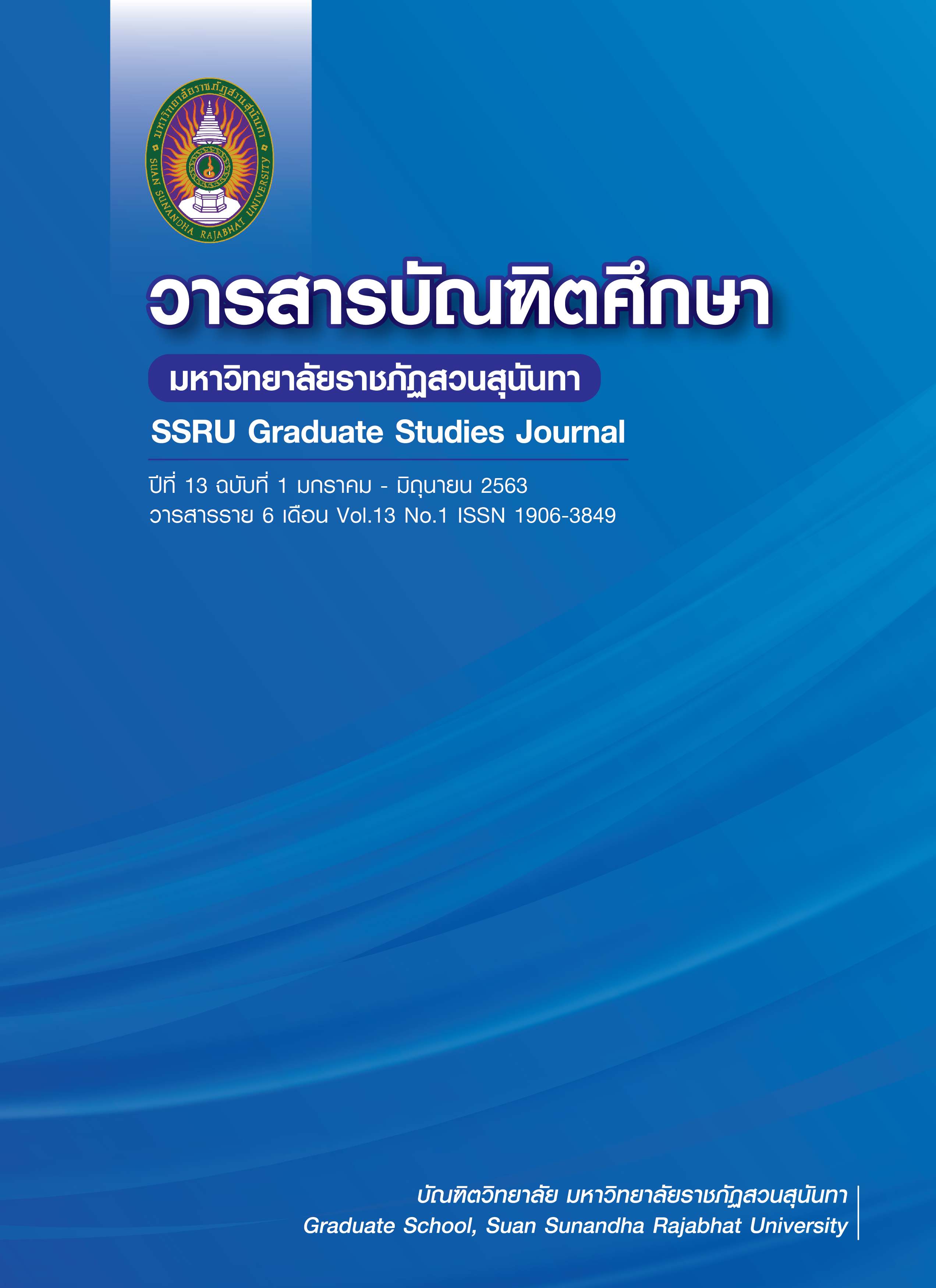The Effects of Lecturer Engagement and the Antecedents on the Lecturers’ Perception of Rajabhat Universities’ Competitiveness
Main Article Content
Abstract
The objectives of this research were to study: (1) effects of the management of talent lecturers on their retention, engagement and perception of the university’ competitiveness; (2) effects of the retention of talent lecturers on their engagement and perception of the university’s competitiveness; and (3) effects of the engagement of talent lecturers on their perception on the university’s competitiveness.
This research employed a mixed research methodology. A quantitative research was used as the main method and a qualitative research method was to support and confirm the research results. In the quantitative research, the sample consisted of 600 lecturers from universities in the Rajabhat group. Data were collected with the use of a questionnaires and analyzed with a structural equation model. The qualitative data were collected through in-depth interviews with 18 informants. The research findings showed that the management of talent lecturers had an influence on their retention and their perception of the university’s competitiveness. In addition, the retention of talent lectures had an influence on their engagement and their perception of the university’s competitiveness, and their engagement had and influence on their perception of the university’s competitiveness. However, the management of talent lecturers was found to have no influence on their engagement. The findings of this research can be used to apply in the management, retention and engagement of talent lecturers as well as to create their perception of the university’s competitiveness.
Article Details
References
กองนโยบายและแผน มหาวิทยาลัยราชภัฎวไลยอลงกรณ์ ในพระบรมราชูปถัมภ์. (2562). www.plan.vru.ac.th. ค้นเมื่อ 27 ตุลาคม 2562.
ดาว์พงษ์ รัตนสุวรรณ. (2562). บรรยายพิเศษตรวจเยี่ยมการดำเนินโครงการยุทธศาสตร์มหาวิทยาลัยราชภัฎเพื่อการพัฒนาท้องถิ่น. มหาวิทยาลัยราชภัฎวไลยอลงกรณ์ ในพระบรมราชูปถัมภ์. ปทุมธานี.
พระราชบัญญัติการอุดมศึกษา พ.ศ. 2562. (2562). ราชกิจจานุเบกษา. 1 พฤษภาคม 2562.
พระราชบัญญัติบริหารกระทรวงอุดมศึกษา วิทยาศาสตร์ วิจัยและนวัตกรรม 2562. (2562). ราชกิจจานุเบกษา. 1 พฤษภาคม 2562.
ระเบียบข้าราชการพลเรือนในสถาบันอุดมศึกษา (ฉบับที่ 2) พ.ศ. 2551. (2551). ราชกิจจานุเบกษา. 5 กุมภาพันธ์ 2551.
สมบัติ กุสุมาวลี. (2553). อ่าน HR มาเล่า เอา HR มาเขียน (HR Synergy No.1 IN OD Major). กรุงเทพฯ: สนพ. แห่งจุฬาลงกรณ์มหาวิทยาลัย.
สำนักงานคณะกรรมการการอุดมศึกษา. (2560). รายงานจำนวนบุคลากร ปีการศึกษา 2560 ภาคเรียนที่ 1 จำแนกตาม ประเภทสถาบัน ชื่อสถาบัน ประเภทบุคลากรย่อย (มีชั่วโมงสอนและมีชั่วโมงช่วยสอน) และเพศ. http://www.info.mua.go.th/information/show_all_statdata_table.php?data_show=4. ค้นเมื่อวันที่ 25 กันยายน 2561.
อาภรณ์ ภู่วิทยพันธุ์ (2558). กลยุทธุ์การบริหารและพัฒนาพนักงานดาวเด่น. เอช อาร์เซ็นเตอร์ จำกัด. กรุงเทพมหานคร.
Anitha J., (2014) "Determinants of employee engagement and their impact on employee performance". International Journal of Productivity and Performance Management, Vol. 63 Issue: 3, pp.308-323
Bartol K.M. and Martin D.C. (1991). Management. New York; McGraw-Hill.
Christos Sigalas. (2015). Competitive advantage: the known unknown concept. Management Decision, Vol. 53 Issue: 9, pp. 2004 – 2016.
Clive Wilson. (2012). Strategic engagement and alignment of corporate talent. Development and Learning in Organizations: An International Journal, Vol. 26 Issue:5, pp. 4 -8.
Henricsson et.al. (2004). Rethinking competitiveness for the construction industry. Association of Researchers in Construction Management.
Jyotsna Bhatnagar. (2007). Talent management strategy of employee engagement in Indian ITES employees: key to retention. Vol. 29 Issue: 6, pp. 640 – 663.
Jurše, M. and Mulej, M. (2011), "The complexities of business school alignment with the emerging globalisation of business education", Kybernetes, Vol. 40 No. 9/10, pp. 1440-1458.
Kumar H. and Raghavendran S. (2013). Not by money alone the emotional wallet and talent management. Journal of Business Strategy, Vol. 34 No. 3. pp. 16-23.
M.E. Porter. (1991). Towards a dynamic theory of strategy. Strategic Management Journal, Vol. 12, 95-117.
Michael Baker, Diane Kubal and Tom O’Rourke. (2006). How to use innovative approaches to retain key talent. Strategic HR Review, Vol. 5 Issue: 6, pp. 5
Nada Al Mehrzi, Sanjay Kumar Singh, (2016) "Competing through employee engagement: a proposed framework". International Journal of Productivity and Performance Management, Vol. 65 Issue: 6, pp.831-843


